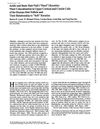Suprabasal Change and Subsequent Formation of Disulfide-Stabilized Homo- and Hetero-Dimers of Keratins During Esophageal Epithelial Differentiation
March 1993
in “
Journal of Cell Science
”
TLDR Keratins K4 and K13 form stable dimers in mature esophageal cells, aiding cell stability.
The study investigated the differentiation of rabbit esophageal epithelium, focusing on the keratin pair K4 and K13. It was found that these keratins were largely absent in undifferentiated basal cells but present in suprabasal cells. During the terminal stage of differentiation, K4 and K13 formed disulfide-crosslinked dimers, including two heterodimers and one homodimer. These dimers contributed to the formation of cornified cells with stability and rigidity suitable for esophageal function. The research suggested that homodimer interactions, previously considered unimportant, might stabilize mature keratin filaments.
